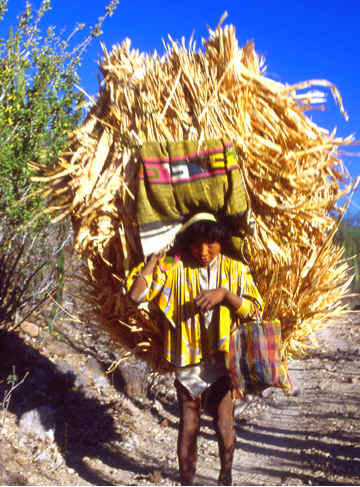
Long Distance, Heavy Weight
Grain transport throughout the Paquimé/Anasazi/Mesoamerican system from the growing fields to the storage facilities ranged from at least 60-90 miles to the occasional much longer distance; weights carried ranged from 100-150 pounds (Malville 2000). Numerous dramatic historical accounts of efficient foot transport of commercial food and utilitarian goods have been documented worldwide. The table below, assembled in July 2003 by Mary Ellen Ergle, Park Ranger, shows weights carried by Tlingit packers over the Chilkoot Trail in the late 1800s.
Even today, this mode of transport is widely used in Nepal and other mountainous and roadless areas of Central Asia . In a 1995-1996 study conducted on three major trade routes in eastern Nepal, porters were found to carry loads ranging from 59 kg (about 130 pounds) to 79 kg (about 173 pounds), with some exceeding 90 kg (198 pounds) (Malville 2000). Male porters as young as 10 were carrying loads that averaged 74 pounds. One trade route, from Jiri (elev. 1990 m) to Namche Bazaar (elev. 3440 m) has a cumulative elevation gain of about 6500 m over its length of 95 km (about 152 miles). While Nepal is more mountainous than Oasis America , elevations are similar (about 1200-3500 m) (Malville 2000).
Based on my natural and human systems model , it is clear that the Paquimé/Anasazi/Hohokam were eminently capable of carrying similar weight loads over similar distances. In fact, the Lightfoot efficiency transport model of 50 pounds and 30 miles is within the current Tarahumara range of daily economic and food redistribution activity .
Documented heavy weight loads that were carried short distances in Oasis America include logs and round stones found at Chaco . Long distance carrying involved the trade in Scarlet Macaws (discussed later in this paper) and is verified by the two tons of shell from Banderas Bay found at Paquimé.